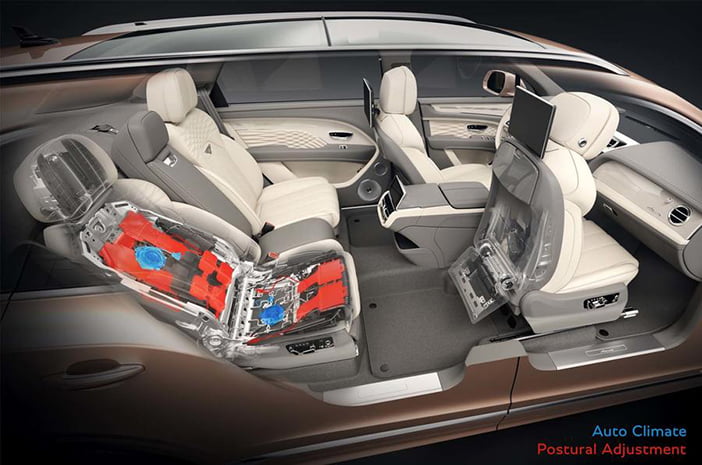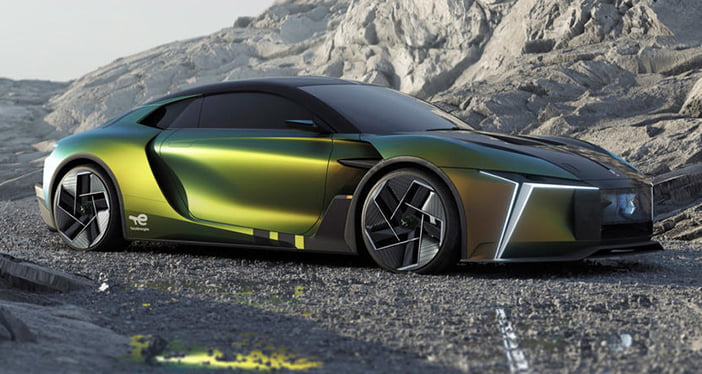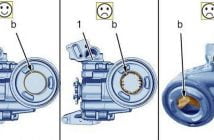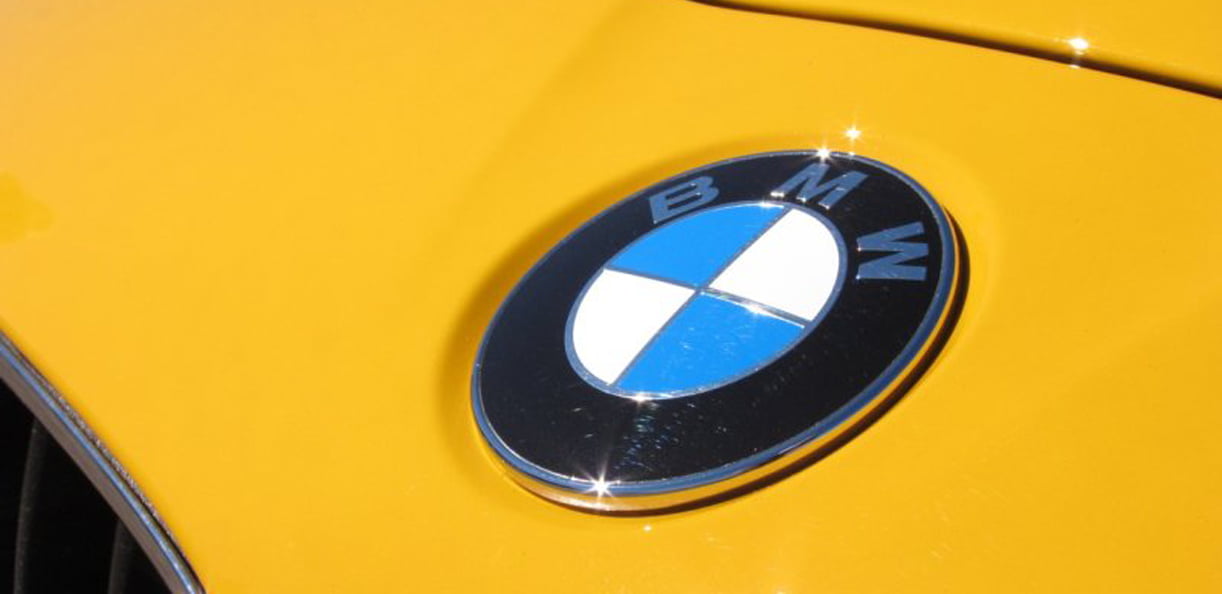+++ ASTON MARTIN will reveal 2 new cars at the Pebble Beach Concours d’Elegance in August, one expected to be a roadster version of the recent V12 Vantage and the other an “ultra-exclusive” car to celebrate the 10th anniversary of the company’s bespoke Q service. Talking about the first, as-yet-confirmed car, Aston Martin said it will be a high-performance model in a similar vein to the DBX 707, V12 Vantage and Valkyrie. If the model is the V12 Vantage Roadster, it would fill an important gap in Aston Martin’s range. The last V12 Vantage Roadster model went off sale in 2018, although the V8 is available as a convertible. Aston Martin described it as a “truly thrilling performance-focused model” with “high-octane emotion and intense driving pleasure”, set to be revealed on Friday 19 August at its private club at the American motor show. On the “ultra-exclusive” model, the firm added that it would “encapsulate the brand’s winning track bloodline, with a nod to success at the 24 Hours of Le Mans”. Aston Martin’s biggest success in the world-famous race series was during the 1950s, when Sir Stirling Moss helped guide the firm to victory in the DBR1. Both cars will showcase the new Aston Martin creative identity, which includes changes to its logo for the first time since 2003. The company said it adjusted its creative image in a bid to appeal to a broader market audience. Aston Martin also said it would update the public on the development of the Valhalla. It will present the interior of its radical, mid-engined Ferrari SF90 Stradale rival for the first time, and potential buyers will have the opportunity to sit inside. The Valhalla, which is powered by a 950 hp V8 hybrid powertrain and limited to 999 examples, made its first US appearance at Pebble Beach last year. “As one of the premier luxury events in the world, the Pebble Beach Concours d’Elegance is an important opportunity for Aston Martin to connect with our loyal customers and showcase our latest product offering,” said Aston Martin marketing boss Renato Bisignani. We look forward to celebrating Aston Martin’s new era of performance at Pebble Beach and displaying our iconic ultra-luxury models, including a world-first reveal of an exciting new model and the public debut of another thrilling addition to our breathtaking portfolio”. +++
+++ Seating may not be the first thing that springs to mind when pondering car tech, but unlike living room sofas, car seats can be highly sophisticated pieces of equipment. Back in the 1960s and 1970s, the opposite was true until some car companies, notably Saab and Volvo, started making dramatic improvements. Prompted by freezing Scandinavian winters, both firms started to look at the value of seat comfort and its effect on the well-being of drivers. They employed orthopaedic specialists to design seats and added seat heating not just for cosiness but also because warmth is healthy for a driver’s back and reduces fatigue. At the time it was advanced thinking, so how have things evolved since then? These days, the role seats play in reducing fatigue means that technical improvements have tripped off the scale, with crash-resistant fixings, integrated seatbelt tensioners, airbags, high-tech interlayers and covering fabrics and integrated infotainment screens. The pinnacle of seat sophistication is, unsurprisingly, lurking in the rear of the most luxurious cars, and the new BENTLEY Bentayga EWB Airline Seat Specification is one of the latest examples. As well as the hand-stitched loveliness you might expect on the outside, the insides of the seats are a mixture of chiropractor’s consulting room and climate laboratory. Taking the second of those first, the seat has an ‘auto climate system’ incorporating a suite of sensors that measure passenger contact surface temperature and humidity to an accuracy of 0.1 degree Celsius every 25 seconds. The passenger has control of where they want that to be from a choice of seven settings. One of those is neutral, which applies preset algorithms figured out during testing with different passengers. From then on, claims Bentley, the seat makes changes it knows are needed before the passenger does. Although the heating tech is unchanged from previous designs, a new type of cooling fan can move around 80% more air than before. For some, seat massage systems are about as relaxing as a child kicking the backrest, but the Bentley doesn’t have that. Instead, it has something called ‘postural adjustment’ aimed specifically at keeping fatigue at bay. The system consists of 6 pneumatic zones that adjust the contact pressure between body and seat, but in a subtle way, says Bentley. In all, the system can make 177 individual pressure changes across the zones. The activity includes three-dimensional twists, using movements developed in conjunction with a chiropractor. From that input, Bentley, with specialist Comfort Motion Global, developed algorithms and evolved the system during scientifically based trials. In studies, it was found that supporting bodyweight dynamically and morphing to each individual’s weight and shape relieves strain that can lead to what Bentley calls a “lack of focus”. Those early pioneers of the 1970s were well ahead of the game, and understanding the importance of how seating technology can improve well-being during a longer journey has been a game-changer. +++

+++ BMW is currently testing the upcoming 4th generation X3 on the road and it looks like the mid-size SUV will gain a completely new look. I expect it to be the last X3 to come with an internal-combustion engine, alongside all-electric variants. The front will feature a larger kidney grille and thinner headlights than the current X3. The headlight design looks like it’ll forgo the split style of the new 7 Series and X7. I could also see a ridge in the bonnet from the BMW badge, a design trait used on the M3, i4 and XM. The wheel arch profile will be similar to the current car’s, as is the upswept window line to the rear pillar, creating the brand’s famous ‘Hofmeister kink’. I expect the rear lights will be 2 separate units rather than a single light bar. The roof spoiler at the back will grow. The current X3 was facelifted in June 2021 so we’re not likely to see the next-generation car revealed until the end of 2023, with an on-sale date of 2024. This arrival is an awkward time for BMW as the X3 would just miss out on the introduction of the ‘Neue Klasse’ platform scheduled to launch in 2025. It means that the all-electric iX3 (based on the current X3) will stick around well into the next X3’s lifecycle. The new X3 will likely be based on an updated version of BMW’s CLAR platform, which accepts mild-hybrid, plug-in hybrid and pure-EV powertrains. A mix of 4-cylinder petrol engines and 6-cylinder petrols with electric assistance are expected to make up the bulk of the range. The current X3 M uses the same 3.0-litre turbocharged straight-6 motor as the M3, and as we’ll see the adoption of hybrid technology in an M car with the upcoming BMW XM so don’t be too surprised if the X3 M follows suit. I haven’t seen inside the next-generation X3 yet, but the infotainment system will surely be based on the latest version of the firm’s OS 8 operating system. It should display on a curved display made up of a 14.9 inch digital instrument cluster and a 12.3-inch infotainment screen first seen in the iX. +++
+++ A production version of the 820 hp DS E-Tense Performance prototype could be on the cards, which would be sold as a track-only, limited-run car, packed with Formula E technology. With a 0-100 kph time of just 2.0 seconds, the electric car would be one of the fastest ever produced, but would command a “very high” price, DS CEO Béatrice Foucher has told. The hyper-quick E-Tense Performance coupé, which is an update of the 408 hp DS E-Tense concept, houses a 340 hp motor at the front and a 480 hp motor at the rear, which combine to make 820 hp. It was revealed earlier this year as part of a development project with engineers from Formula E team DS Techeetah, which the French firm has a big stake in. Currently, DS (which only became its own brand following its separation from Citroën in 2014) does not sell any sport-focused cars, concentrating solely on the premium market, with models such as the 4 hatchback, 7 SUV and 9 saloon. Speaking at the London ePrix, Foucher said: “We would never go to sporty cars, that is not the positioning of the brand, but at the end of the day when everybody saw the E-Tense Performance prototype, we said ‘okay, that would be good if we could build one, or sell this type of car’, but the decision has not been made yet”. She added: “If we take the decision, we’ll embed the technology that we have learned from Formula E, so it means that, in terms of homologation, it would not be possible to homologate for the road, so it would be only for the track, and if you build a car for the track, this would be in very small volumes, and very high costs and prices. “I don’t know if there is any good equation for that, but everybody loved the car, which is good for us, and so we’ll have to see”. Asked if a production variant could pull ideas and technology from sportier brands within the Stellantis group, such as Alfa Romeo, Foucher said: “Obviously what Stellantis are designing in terms of technology, generally speaking, fits for all the premium brands, so yes in terms of powertrain, batteries and electric models”. +++

+++ LAMBORGHINI is poised to announce 2 new variants of the Urus SUV and a new version of the Huracán supercar in the wake of a record half-year. Despite the challenge of semiconductor shortages and supply-chain issues exacerbated by the war in Ukraine, Lamborghini delivered 5.090 cars; 4.9% more than in the first half of 2021. The Urus was the brand’s strongest performer, accounting for 61% of all sales, while the Lamborghini Aventador and Huracán supercars made up the remaining 39%. Lamborghini will begin to unveil the aforementioned Urus and Huracán variants from August. The Lamborghini Urus ‘Evo’ has already been spotted testing in Germany with matt-black paint and bright-red brake calipers. It’s expected to pack slightly more power than the existing version while cutting weight below 2.200kg. The other Urus due to be announced is expected to be a plug-in hybrid (PHEV) version, poised for a 2024 launch. It’s likely to use the 680 hp powertrain from the Porsche Cayenne Turbo S E-Hybrid. The new Huracán, meanwhile, is expected to be a production version of 2019’s Sterrato concept. Spotted testing in January 2022, it features high-riding, off-road ready suspension similar to that on the Porsche 911 ‘Dakar’ and ‘Safari’. The Huracán Steratto is expected to feature an adapted version of the 4-wheel drive system from the regular Huracán Evo, as well a tuned version of its 640 hp V10 engine. More aggressive styling may also feature, as with the recent Huracán STO and Huracán Tecnica special editions, including motifs such as an LED light bar. Pricing may reach Aventador territory. The Sant’Agata-based company’s profits increased by 69.6% compared with the first half of 2021, from €251 million to €425 million. Lamborghini credits this to the increase in sales as well as the higher uptake of customisation through its Ad Personam division. Sibling brand Bentley’s Mulliner customisation program was similarly key to its success. The United States was Lamborghini’s top market, accounting for 1.521 sales, followed by China (576) and Germany (468). +++
+++ MERCEDES is undergoing testing of the revised GLB and the firm is keeping exterior tweaks to be kept to a minimum. It looks like a debut could happen this year. Introduced in 2019, the Mercedes GLB is a bit of an anomaly in the German firm’s line-up, it offers 7-seats where the more expensive GLC is 5-seat only. There’s also an all-electric EQB version, giving the GLB a broader appeal than the GLC. The front of the facelifted GLB will feature a new, simpler headlight design with just one daytime running strip in each cluster. The grille’s shape remains the same, but we can expect new detailing within. For the AMG sporty variants I expect a new front end with larger air intakes and a bespoke grille design. The sides remain unchanged from the outgoing model, but at the rear there will be a new rear light design with horizontal bars replacing the square lights. In some Mercedes models, such as the new S-Class and EQS, we’ve seen a variation of interior design between the combustion-engined car and its electric counterpart. The GLB and electric EQB, received the same interior layout and I expect this to continue with this mid-life update. Since the GLB was launched, Mercedes has brought out new versions of its similarly-sized GLC and C-Class. Inside, these cars use a new 11.9-inch portrait touchscreen and 12.3-inch digital instrument panel; technology that could be carried over to the GLB, with the latest MBUX infotainment. In terms of powertrains, we’re likely to see a continuation of the current range. This will start with the entry-level GLB 200 with a 163 hp, 1.3-litre turbocharged 4-cylinder petrol, while the only other petrol will be the range-topping GLB 35 AMG with 306 hp from its 2.0-litre turbocharged petrol engine. Diesels take the form of the GLB 200d with a 150 hp 2.0-litre 4-cylinder diesel and the GLB 220d with a 190 hp 2.0-litre 4-cylinder diesel. Given there’s the all-electric EQB built on the same MFA2 platform, a plug-in hybrid variant of the GLB should arrive at some point too. +++
+++ The next-generation PORSCHE Panamera has been spotted testing again, this time in the United States. I expect the new third-generation Panamera to go on sale in 2024, given the current one launched in 2017 and was facelifted as recently as 2020. It will be a new car, but evolutionary against the second-generation model, given the sales success of the all-electric Taycan; now convincingly outselling the combustion and hybrid-powered Panamera. At the front there will be Porsche’s signature quad daytime running lights within a rounded unit and a revised bumper design with larger air curtains om the Turbo version (the less sporty model I’ve previously seen has smaller intakes). Porsche won’t change the general layout of the interior too much, but it could take on a similar look inside to the Taycan, employing a revised infotainment and switchgear setup mimicking that of its all-electric sibling. Porsche updated its 6th generation Porsche Communications Management earlier this year, but by 2024 we could see an all-new infotainment system on a fully digital instrument panel. At present, the Panamera uses a partly digital layout, with an analogue rev-counter. It’s unclear as to whether the new car will retain the same 2.9-litre twin-turbocharged V6 and 4.0-litre twin-turbocharged V8 powertrain options, but we should see the Turbo S E-Hybrid continuing to top the range. +++
+++ The new SUZUKI Swift is expected to have softer, Mini-esque styling when it’s released next year. Spotted testing for the first time, photos reveal an evolutionary look over the current Swift, with pumped-up wheel arches and a rounder front end featuring a curved bonnet shutline and a smaller front grille. The reduction in size is especially noticeable at the lower bumper, where the outgoing car’s U-shaped section now appears to be a less broad oval. Other changes spotted include the rear door handles, which have moved from the C-pillar to a more traditional position below the window. The warm Swift Sport might have its front end reworked with sharper lines and a more prominent grille, bringing it into line with the Vision Gran Turismo concept car, unveiled virtually earlier this year. Given the budget-friendliness of the Swift, it’s unlikely that the new car will receive a significant technological overhaul. This is in spite of Suzuki’s partnership with Toyota, which has renewed its focus on hybrid technology in its superminis, including the Yaris. This means that the new Swift is expected to receive an upgraded version of the current car’s 82 hp 1.2-litre 4-cylinder mild-hybrid petrol engine. The same goes for the 129 hp 1.4-litre Swift Sport. Nor is much expected to change inside the Swift, although the 7.0 inch touchscreen that’s standard on the Sport might become standard across the whole range. A head-up display, as featured in the Vision Gran Turismo, could be included on range-topping versions, too. +++



